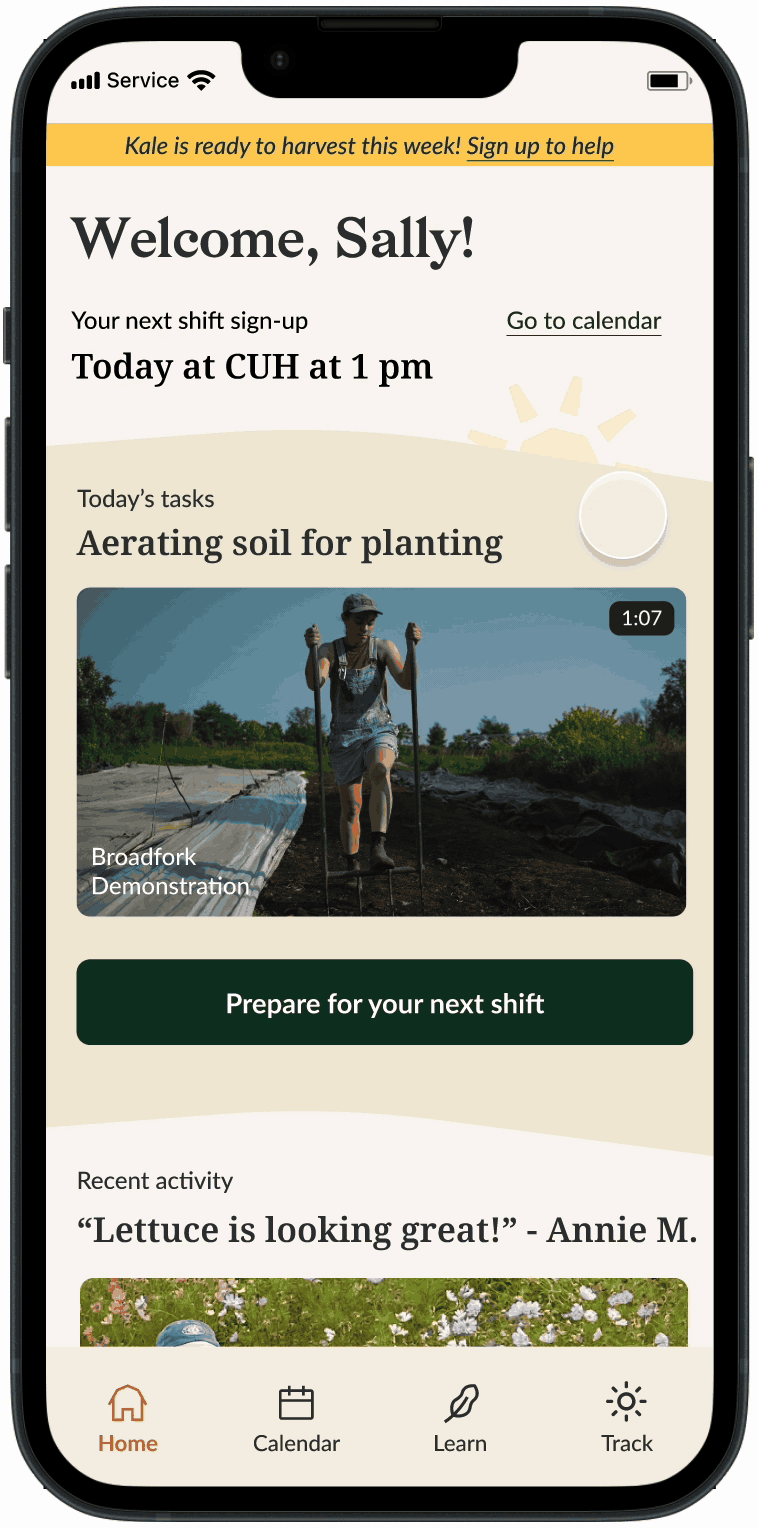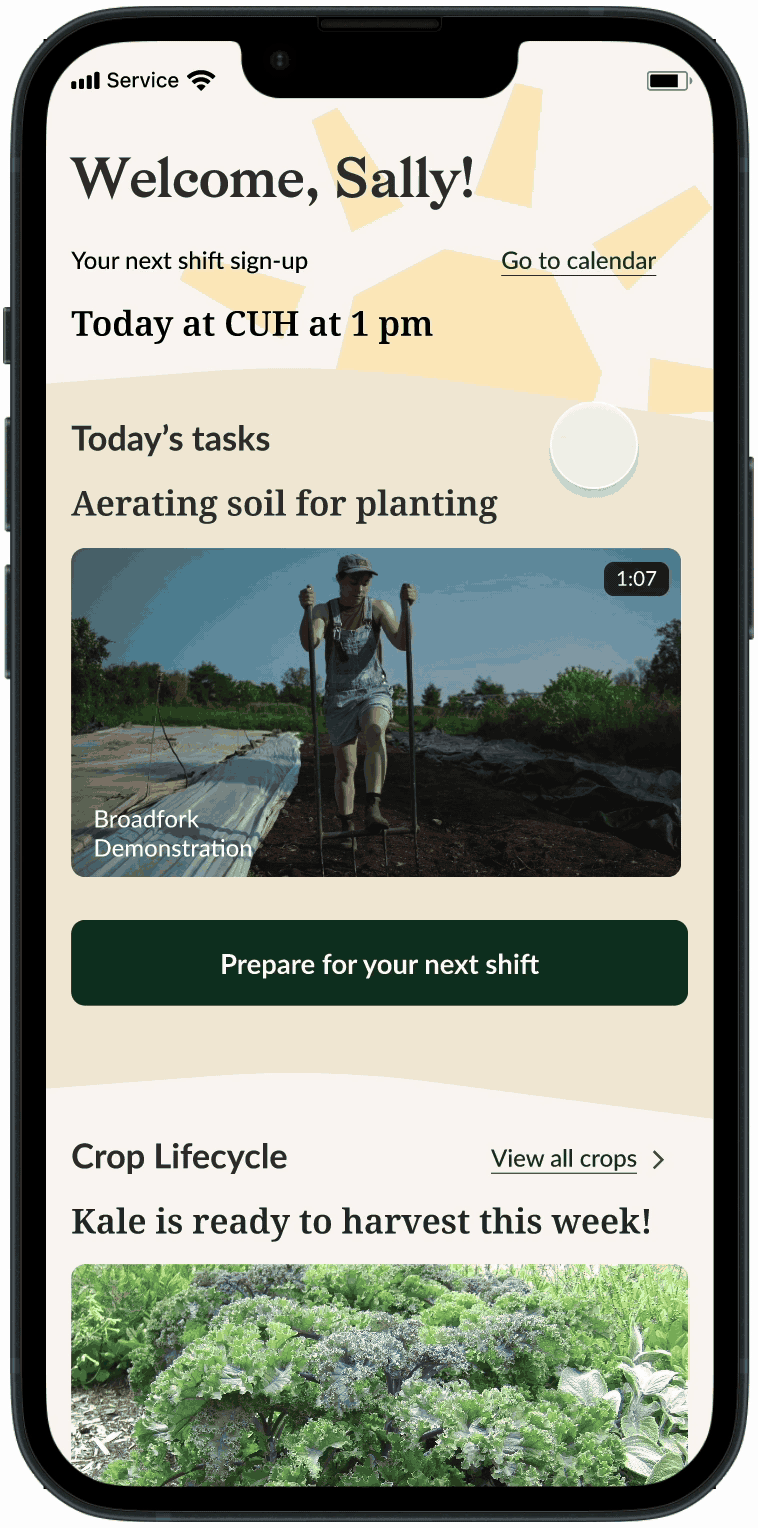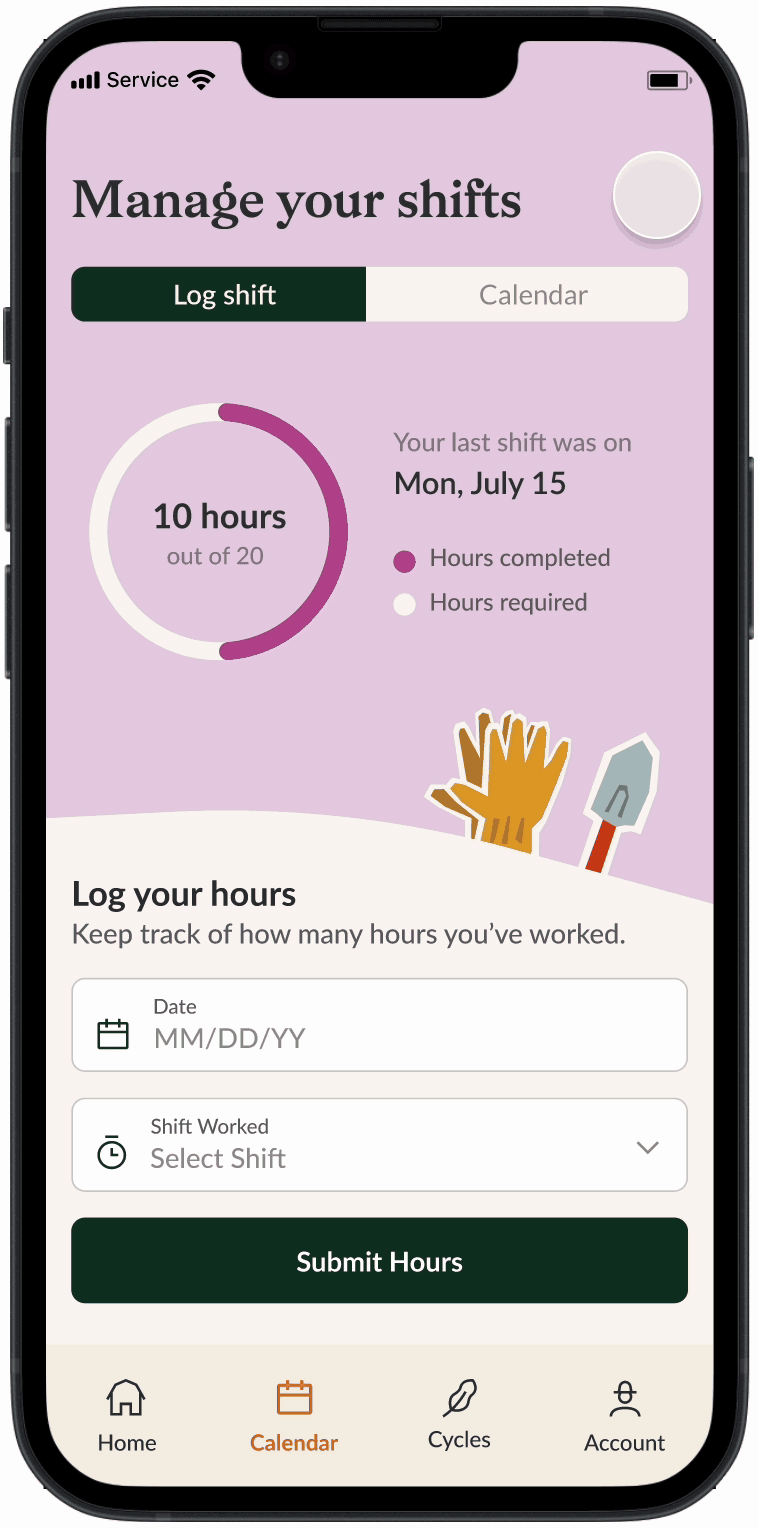Rooted
Mobile app
OVERVIEW
A seamless, centralized training platform for farm volunteers, aimed at improving productivity and volunteer retention
What I Did
UX Research (lead)
UX & UI Design
Videography
Team
3 other designers
Tools
Figma
Timeline
5 months + add’l time spent redesigning UI
CONTEXT
Background
5-month project for my capstone at MHCI+D
My team and I were interested in the issues concerning the volunteer-run University of Washington (UW) Farm, where we had the opportunity to conduct ethnographic research in the urban sustainability and education space. Over 5 months, my team and I researched, designed, and prototyped an MVP for the UW farm, which I presented in front of over 200 industry guests, peers, professors, and family at our capstone presentation. After graduation, I spent additional time getting feedback and iterating on the UI.
I whiteboarded insights with my team to pinpoint core problems on the farm.
CONTEXT
Problem
An influx of 50-100 inexperienced volunteers every 10 weeks, known as Service Learners
Students looking to fulfill class requirements come to the farm each quarter. Farm leadership are overwhelmed and frustrated by micromanaging them in addition to carrying farm production. Existing solutions include delegating teaching responsibilities to other experienced volunteers. There are online resources that management would like volunteers to use, but volunteers don’t use them because they don’t fit their mental model of the farm.
CONTEXT
Opportunity
Improve volunteer engagement, autonomy, and retention
The farm also has volunteers who are experienced and capable. They are intrinsically motivated by camaraderie, understanding how food grows, and seeing the impact of their work. By providing improved educational resources and making them personally meaningful, we can better support new volunteers and help them grow into a strong, engaged community.
short-term design opportunityEducate service learners on basic farm tasks and crop knowledge, unburdening leadership and making farm work more efficient.
long-term design opportunityRetain service learners, transforming them into a larger base of ongoing, experienced volunteers that can be relied upon.
CONTEXT
Stakeholders
Primary Stakeholder and Key User
Suffers from unmet informational needs and difficulties communicating
Service learners, farm leadership, and the farm ecosystem at large are affected
The farm has a broad ecosystem including the incoming new service learner volunteers, farm leadership, a variety of volunteers who come of their own volition, some with more experience levels, interns, adults from the outside community (often retirees), and members and families of the general public who come on special planting days such as Earth Day and MLK Day.
Secondary Stakeholder
Overwhelmed with tasks—balancing the volunteer program and farm production
Tertiary Stakeholder
Gave us valuable insights into intrinsic motivations for engaging with the farm
“We have students for 10 weeks and then they disappear… it’s always a new group revolving like a turnstile… we have that as a disadvantage.”
— UW Farm Manager
DASHBOARD
A centralized platform for volunteer resources
CROPS
Own crops and their growth cycles
TASKS
Prepare for shifts with itemized videos
CALENDAR
Schedule shifts and log service hours
RESEARCH
Qualitative Research
Key Insights
We synthesized quotes and notes through an affinity map process. Here are the top 3 insights.
1/ Service learners are mostly extrinsically motivated and repeat volunteers are intrinsically motivated.
Recommendation: Generate intrinsic reward for service learners.
Semi-structured interviews and ethnographic research
Our research question was “What are the points of friction and points of opportunity in the UW Farm volunteer journey?” We volunteered over 20 hours in shifts each, and I experienced the pain points of being a newbie farmer firsthand, as well as observing leaderships’ behavior and attitudes. During shifts, we also recruited 11 participants of varying skill-levels and backgrounds — I conducted 5 out of the 11 interviews.
LEFT: My team and I immersed ourselves in the farm by volunteering over 20 hours each. RIGHT: Interviewing the farm manager while she prepared bouquets for the farmer’s market.
2/ Repeat volunteers are reliable because they are autonomous, productive, and can lead newer volunteers.
Recommendation: Lock in service learners as long-term volunteers.
3/ Farm staff wants a source of information that is going to be conveniently accessible to students.
Recommendation: Centralize and enhance farm information.
RESEARCH
Service Journey Map
We pinpointed informational needs by mapping corresponding pain points between learners and staff in a service journey map
We took quotes and findings from our qualitative research that described feelings, needs, pain points, and activities during a shift, so that we could see how the experiences of service learners and farm staff overlapped. As a result, we identified key pain points including breakdowns in instructions, communication challenges, and task delegation.
Click to open our service journey map depicting pain points across shift tasks for both service learners and farm staff in a new window.
IDEATION
Brainstorm
DESIGN PRINCIPLES FOR DOWNSELECTION
I and another teammate wrote HMWs focusing on the different pain points we identified, and we brainstormed over 20 ideas.
Having multiple mini-HMW statements helped consider different angles to possible solutions, including form factor, time of use, and pre-existing protocols.
3 of the 6 mini-HMWs we used to brainstorm ideas.
My team and I used sketches to articulate our ideas, and pinned them to a whiteboard where we could categorize, rate, and downselect them based on design principles we wrote based on our research before ideation.
Our whiteboard of narrowed down ideas, ranked by alignment with number of design principles.
Autonomy
The solution should support volunteers to be autonomous.
Impact
The solution should convey the impact of the farm work.
Education
A solution should provide a source of information to volunteers that is convenient and accessible.
Community
A solution should help volunteers feel that they belong on the farm and are connected to their community.
IDEATION
Selected Idea
A “crop tracker” that keeps users abreast of important crop events, such as planting and harvest time, through a social lens
We narrowed down to two ideas, the other one being an interactive digital bulletin board and ultimately chose this crop tracker idea, or the proto-Rooted.
Why We Chose It
In addition to meeting our design principles, there was
nothing like it on the market,
the flexibility of using a mobile app on volunteers’ individual devices, and
the ability to connect volunteers who don’t always work together.
We would need to avoid the trap of creating a flat “progress tracker” that isn’t also educational.
I iterated on the design using storyboarding, sketches, and wireframes
We collaborated on a storyboard to create and iterate on feature ideas and key touchpoints, such as when users would prepare for their next shift. Using a storyboard was a helpful tool to think through the temporality of important features such as when service learners would prepare for their shift activities.
My team and I combined our storyboard panels to define key touchpoints and features.
IDEATION
Concept Refinement

“If students are involved with the farm over a series of seasons, they become people who can run the field.”
— UW Farm Manager
RESULTS
Dashboard
Volunteer-friendly guide to farm life, all in one place
The home screen consolidates volunteers’ information needs into a centralized place that fits their mental model of the farm itself as the source of information.
RATIONALE
The farm’s digital presence is scattered and overlooked; ergo, volunteers frequently ask the farm manager questions that have answers online, causing her frustration. She wants volunteers to be more resourceful before coming to her.
DESIGN DECISION
Having everything a volunteer needs, including updates about fun events, in one place, makes it more intuitive for them to seek out answers on their own.
RESULTS
Tasks
Shift-based how-to videos that support distributed learning
The Upcoming Tasks flow guides volunteers through their tasks for a shift, including how-to videos (such as those on the farm’s YouTube) preparing them for their work.
RATIONALE
Learners benefit from learning by observation as well as a “do stuff as it comes” style, but mistakes still frequently happen when they miss instructions.
DESIGN DECISION
How-to videos that are accessible before and at any time during the shift provide a distributed learning experience as well as a resource that volunteers can fall back on at any point while working.
RESULTS
Growth Care
Tend key crops with timely, informed care
Volunteers can be autonomous and stay personally invested by keeping tabs on farm activity and how crops are doing. Viewing recent activity from the community provides a social lens.
RATIONALE
One of the themes we found across experienced volunteers was sticking around because they get attached to the whole process and want to take on more responsibility. We also found that they enjoy the friendships they make on the farm.
DESIGN DECISION
Two main categories—crops that most need attention and favorite crops encourage urgency and sovereignty over farm work, respectively. Social activity encourages volunteers to stay connected with their friends and the spirit of teamwork.
RESULTS
Crop View
Stay abreast and contribute to crop activity
Volunteers can view an individual crops, progressing through the normal stages of a crops’ growth cycle, starting from seed planting through harvest and distribution. Volunteers are able to upload photos from their work days as well as see uploads from their fellow volunteers and feel connected even to other work parties.
DESIGN DECISION
A circular timeline represents the non-linearity of cyclical growth on the farm. Photos rotate with each stage of the cycle.
RATIONALE
When talking to long-time volunteers, we learned that they are motivated by seeing the impact of their work (such as seeing growth progress or seeing food being distributed) as well as feeling connected to others on the farm.
RESULTS
Calendar
Stay on track and join a shift
Service learners are required to fulfill a certain number of hours requirements for a 10 week period. Here they can ensure they’ll meet the requirement as well as sign up for their next shift(s).
DESIGN DECISION
Combine the hours logger and shift sign-up in one feature.
RATIONALE
Volunteers don’t fill out the shift sign-up Google form, which creates a pain point for leadership when planning a day’s work because they need to know how many volunteers to expect. Moving hours logging in-app and combining with the sign-up incentivizes volunteers to do both.
RESULTS
Proof-of-concept video
EVALUATION
Measuring Success
I showed our video to the farm committee co-chair and an experienced volunteer. Their feedback has validated Rooted’s potential to:
help train inexperienced volunteers,
build community by facilitating communication and planning among student volunteers, and
integrate well with existing farm operations such as monitoring harvest dates, production metrics, and record keeping for organic certification.
REFLECTION
Next Steps
Here’s what my next steps would be if I continued the project.
Prototype test Upcoming Tasks, Growth Care, and Cycle Tracker
Build out flow to upload videos for volunteer-driven education library
Create companion app for farm leadership
REFLECTION
This was my first time working closely with stakeholders in an ongoing way to design a product. I learned a lot.
The person experiencing the problem can be different from the end-user.
We took a systems-view of the farm in our research. While problems were felt across the farm ecosystem, farm leadership felt the heaviest burden. Service learners, however, are the users of the product because of the ways they contribute to leaderships’ burden.
Gained experience crafting UI.
Always improving my craft!
Using a storyboard helped us ideate for volunteers’ experience both on and off the farm.
Storyboarding was a low-cost, timely method to define and rapidly ideate touchpoints within the user’s journey.
Active listening is a key part of leading.
I led many of our workshops together, including research planning, synthesis, and brainstorming. I found that the most efficient way to gain influence and help the team make decisions came when I actively listened and pointed out convergences in the conversation as well as how they related to best practices.




















